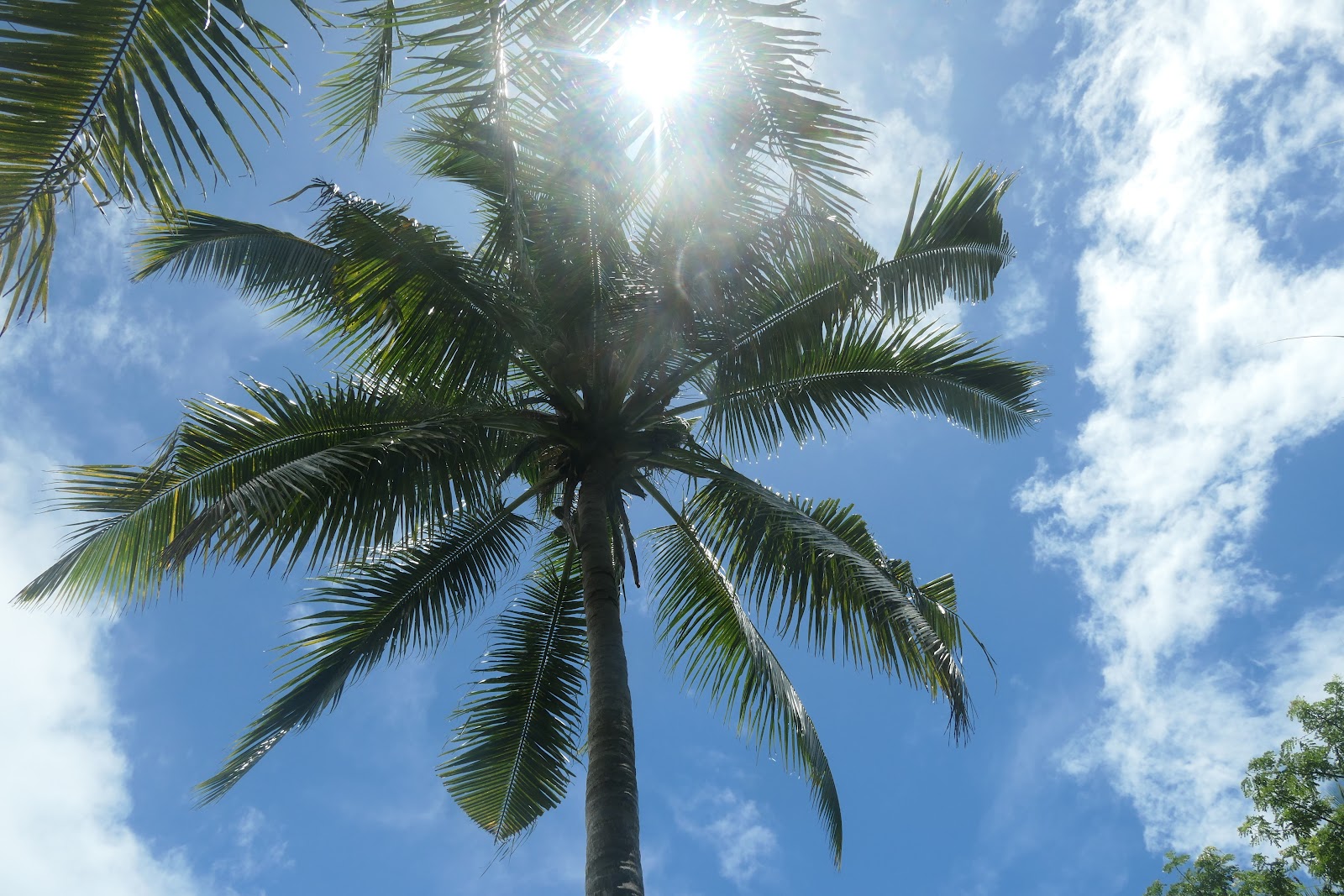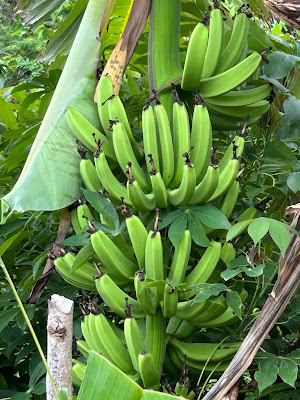240115 Hitting the Coast
Today was moving day.
I woke at 2:22 and didn't sleep again for ages. I think I got some before getting up. Chris slept well.
We had Weetbix and muesli for breakfast again, moistened by half a small box of UHT milk i.e. pretty dry. We had saved a section of banana from last night's fruit platter to add to it.
On checking out, we were charged $F71.50 for last night's meal. Chris had signed for it and we hadn't tallied it but were a bit surprised that it came to that. Maybe it was all above board.
We walked to the airport which is close by and were told at the information desk to wait for a Suva Express bus. It would drop us at the Geckos Resort bus stop and should cost about $F8. While waiting an (official, we assumed) man asked where we were going. He said the bus would be there at 10:00 and the cost would be $F7.89. On the bas we handed over $F16 and got no change. We hadn't really expected it.
Along the south coast there seemed to be lots of Indian names on businesses and Hindu places of worship. We also passed a Muslim cemetery.
The driver had not seemed to know where Geckos Resort was but the man who came around to take out money nodded knowingly when we again said that is where we wanted to stop. As we approached, we got a little nervous about whether it was going to happen but it did.
The resort is right beside the bus stop. It is 3-star although looked very nice in the publicity. It does have the broken, slightly muddy roads and some of it looks run-down but other parts are very nice. We checked in, asked about going to the sand dunes etc. and learnt that there is a free cultural performance including fire dancing on Tuesday nights for those who have paid for dinner here. That's exciting!
We settled into our room then went for a walk around the grounds. There seem to be a good number of staff around but no other tourists yet. There are two nice pools. There are several old structures that seem to have been allowed to deteriorate. There is a hut with information about Fijian culture and history, a restaurant and a shop, plus a gym, a TV room and a covered meeting place.
Lunch consisted of a muesli bar and a few nuts. I then enquired about transport to the Sigatoka Sand Dunes National Park. It would cost $F25 return. We arranged to be picked up at 1:40. We were uncertain about going because it is now the rainy season and it rains in the afternoons. One woman said, "Well, it rains every afternoon". Then another came and said it wasn't going to rain. I said, 'But it rains every afternoon". She just put her finger to her lips and said, "Shhhh". Anyway, we decided to go. If it rained torrentially as it did yesterday we might have been in trouble.
The van driver turned up a little late. He later told us that his business is based at Geckos. He took us the 6.8km to the National Park. We had thought we might take about two hours but he suggested we go and ask the people on reception. The problem was there was no one on reception. The driver looked around and called to someone who eventually came and explained the different tracks. The driver waited while this was all sorted. There were basically two options: the one hour walk and the two hour walk although there were various other tracks that we could also follow. There was no price difference ($F10 each) but the reception man was keen to know which we had decided to do. We decided on the one hour walk but knowing we could follow some other routes. The main thing was that we would see smaller dunes but not the big ones.
We agreed that the taxi driver would return at 4:00 p.m.
The walk was not spectacular. maybe it would have been if we had gone to the bigger dunes, but it was very pleasant nevertheless, although very hot which made it reasonably hard work. We climbed a bit from the visitor centre, then walked along a ridge, mainly through bush but sometimes exposed to the sun. We went some distance past the where the one hour track descended towards the coast - enough to possibly see one larger dune in the distance.
We then doubled back and headed downhill.
When we got to the coast the was a reasonably strong breeze that kept things cooler and we did descend down a sand dune.
The sea was not the typical blue we associate with Fiji but more a green/brown colour. A sign said swimming was dangerous because of strong tides and sharks.
Along the beach there was a whole line of tepee-type structures made from the plentiful driftwood. Who knows what they were for - maybe just something a bit novel.
At the end, we climbed again a bit back to the visitor centre. On the way we have gone through various kinds of forest with some nice flowers. At one point, near the end, we commented on the racket that the birds were making. Then Chris realised that they were fruit bats that we could see hanging up in the trees.
It had been a good walk and quite pleasant except for the heat.
We presume these vines have been wrapped around the roots and trunks of these trees to look like people hugging the trees.
At the visitor centre there was information about Fijian weaving, weapons, canoes etc. with replicas of weapons and examples of weaving.
We didn't see another person the whole time (although there were footprints on the beach). If we had known where to go (and the the maps are accessible) we could have gone in without paying.
One interesting thing about the dunes area is that archaeological digs have found human remains dating back to about 3,000 years. Consequently it is on the "tentative list" of UNESCO World Heritage Sites.
We had a nice swim in the resort pool but felt that the weather was changing so got out. It never came to anything. After that we relaxed.
We had dinner at the resort. We will tomorrow night to so tonight had a lighter meal. I had spaghetti bolognaise and Chris a fettuccini something. With 2 drinks it cost $F75.
Children at the next table got very excited seeing frogs hopping around close by.
Appendix - Archaeology at the Sigatoka Sand Dunes
An AI summary of this paper says...
The Sigatoka Sand Dunes on the Coral Coast of Viti Levu in Fiji have attracted significant research attention in Oceanic archaeology. Over the past few decades, erosion of the dunes has exposed various archaeological materials ranging from the initial period of Fijian settlement to the historic era. Despite numerous studies, the archaeological record at Sigatoka remained enigmatic until the early 2000s.
Before 2000, limited evidence of sustained occupation was found at the site, with few architectural features, faunal remains, or nonceramic artifacts. The abundance of ceramic sherds and human burials did not provide a comprehensive understanding of the site. Furthermore, the usefulness of the Sigatoka ceramic sequence for reconstructing Fijian culture history was questioned.
In 2000, an excavation project was conducted at the eastern end of the Sand Dunes, providing new insights into mid-sequence occupations at Sigatoka. The recovered materials helped resolve inconsistencies and offered an essential dataset for reevaluating Fijian prehistory. The excavation revealed stratigraphically separated habitation floors with distinctive ceramic suites, nonceramic artifact assemblages, and faunal remains.
The ceramics from the lower component, called the Fijian Plain ware phase, displayed similarities to Lapita pottery, indicating continuity in vessel form and technology throughout Fiji's prehistory. The upper component, known as the Navatu phase, had a different ceramic assemblage. It featured new vessel forms, decorative applications, and possibly a variant manufacturing technology. The Fijian Plainware and Navatu phases were found in closely spaced time periods, and their diagnostic ceramics were also discovered elsewhere on the dunes.
This excavation project offers valuable data that helped overcome earlier misunderstandings of the Sigatoka archaeological record. It contributes to our understanding of mid-sequence occupations at Sigatoka and has broader implications for Fijian prehistory as a whole. The Sigatoka Sand Dunes continue to play a significant role in shaping our knowledge of Fijian and Oceanic culture history.
See also:


















Comments
Post a Comment